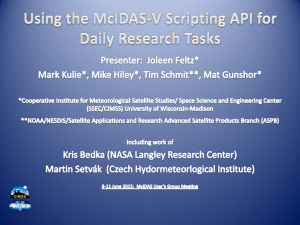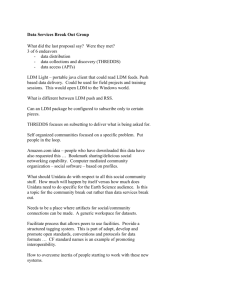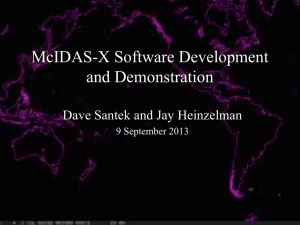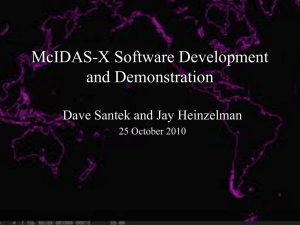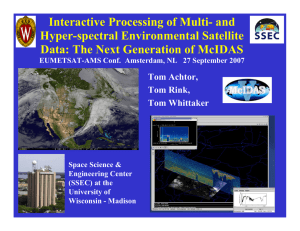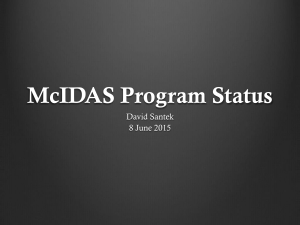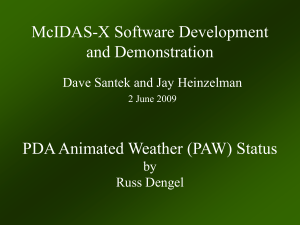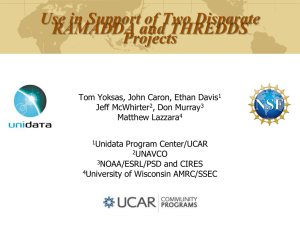Principal Investigator co-Investigator Dr. Monica K. Harkey Dr. Mark S. Kulie
advertisement
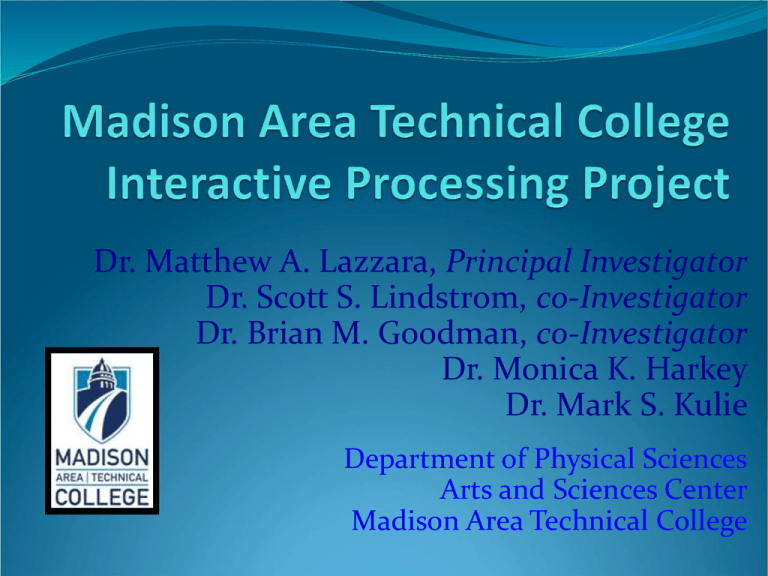
Dr. Matthew A. Lazzara, Principal Investigator Dr. Scott S. Lindstrom, co-Investigator Dr. Brian M. Goodman, co-Investigator Dr. Monica K. Harkey Dr. Mark S. Kulie Department of Physical Sciences Arts and Sciences Center Madison Area Technical College Presentation Outline Introduction & Background Madison Area Technical College Weather and Climate course Unidata Equipment Grant Software and Setup Classroom use of McIDAS-X: Forecasting Course Content via McIDAS-V: Atmospheric Annual Cycle Future Background and Introduction • About Madison Area Technical College (Madison • • • • College) 4 regional campus locations 8 locations in Madison 12 county district 3200+ graduates per year Background and Introduction • Modernization of Weather and Climate Course – One class section (1991-2005) to Six class sections today – Face-to-Face, Interactive Television, On-line, & Hybrid – Desire: • • Use of weather software in the classroom Introduction of interactive processing to the curriculum • Part-time Adjunct Faculty - Wisconsin Connections – McIDAS Project – Unidata Program Weather and Climate Course • History – Established circa 1991 (Ed Addison III) – One class at Truax Campus – Other prior instructors: Mike Coe and Amanda Adams • Current Status – 3 classes at Truax Campus – 1 class at Downtown Educational Center Campus – 2 classes on-line – 1 class in the summer • Transfers to the UW System at AOS 100/101 Grant Arrangements Granting Agency Unidata Program Part of the University Corporation for Atmospheric Research (UCAR) Original Funding Source: National Science Foundation (NSF) - Atmospheric and Geospatial Sciences (AGS) Unidata Equipment Award Funded on 2nd attempt! Targeted for schools like ours! No funding for labor (equipment only) Grantee • Madison Area Technical College – Dr. Matthew Lazzara, PI – Dr. Scott Lindstrom, co-I – Dr. Brian Goodman, co-I – (Dr. Monica Harkey & Dr. Mark Kulie – hired after submission) – Amy Limberg-Dzekute – care taker • Thanks to the Grants Office, Arts and Sciences, and Learner Success! • Acknowledge *key* Support from Kay Lang, Mitch Conners, Alane Spatola, Amy Brown, John Pigeon, Sue Dalton, James Russell, and a cast of many! Grant Specifics • Objectives: – Employ grant funded equipment to utilize Unidata software to aid in the instruction of the Weather and Climate Course along with participating in the Unidata community. • Activities (Milestones): – Equipment purchasing 4 computer system • • Two MacBook Pro laptop systems Two Mac Pro server/display systems – Equipment installation, test, and initial utilization – Project reporting • • • • Article for the Unidata Newsletter Written report (for the College and Unidata, etc.) Newspaper article in the Clarion (College newspaper) Demonstration for interested parties at the College Software Application Software - Data Display/Analysis: McIDAS-X Two dimensional display, animations, ‘paperless’ weather display – satellite, surface observations, text, etc. McIDAS-V (IDV) Multi-dimensional display, animations, numerical model output, satellite observations, surface observations, on the fly zooming, etc. Data Server Software – Data Access: LDM – Data “feeds” McIDAS ADDE (OpenADDE) – Data servers: remote and local Interactive Processing Project: Network Diagram rain.matcmadison.edu snow.matcmadison.edu McIDAS-X McIDAS-V ADDE LDM McIDAS-X McIDAS-V ADDE LDM Backup Data Server Room 350 Primary Data Server Physics Prep Other Systems Laptop McIDAS-V McIDAS-X LDM IDD Feed LDM AntIDD Laptop McIDAS-X McIDAS-V UW-Madison •SSEC •AOS •AMRC •Others Classroom Use: Weather Forecasting In-Class Activity Using real-time weather information Applying course concepts Appreciation for forecast process Working with real data Teaching for conceptual change: Justification Argumentation Single, small & large groups Using McIDAS-V to show Annual Cycles in the Atmosphere Motivation: A picture is worth a 1000 words! Data Grib Data are from model output saved near the 1st of each month (Nov 1st, Dec 1st, Jan 2nd, Feb 1st, Mar 1st, . . . , Oct 1st ) over the course of one year (finally done) First Movie: Surface Temperature Annual cycle of temperature Data are from 00z – closer to the warmest part of the day than to the coldest part of the day Note colorbar scale on the right: from 240.8 K to 319.2 K -- -32 C to 46 C, or -25 F to 115 F Ocean is cooler in summer, warmer in winter; Great Lakes warm in winter, cool in summer. Rocky Mountain tops stay cool all year long! Warm water of Gulf Stream is visible for most months. Movie would look different in spots if you used a different year’s data, but overall patterns would be similar Surface Temperature Second Movie: Mean Sea Level Pressure Annual cycle of Mean Sea Level Pressure Note colorbar scale on the right: from 965.93 mb to 1038.38 mb. Hurricane Earl is in one of the maps. 1038 mb is the central pressure of a fairly strong high pressure system Position of high and low pressure systems is pretty random; however: Note how the position of the subtropical high off the west coast of the US drifts northward in summer, then southward again starting in September. This reflects the seasonal change in the General Circulation: features move towards the Poles in Spring and Summer, and back towards the Equator in Fall and winter. Mean Sea Level Pressure 500-mb heights February – note the variability – from August – much less variability – from red red (5800) to blue (4800). Biggest change over central US – that’s where the jet is (5900) to green (5200). No big gradients, no strong jets 500-MB HEIGHT COMPARISON February and August, viewed from northeast – February and August, viewed from southwest – 500 mb surface much closer to surface when atmosphere is cold, and it’s much higher when atmosphere is warm 500 mb surface much closer to surface when atmosphere is cold, and it’s much higher when atmosphere is warm Height surface in February Height surface in August What’s Next? Continue saving model output files, compare one monthly data from one year to the next (that is: November 2009 vs. November 2010) Interannual variability – compare annual cycle this year to annual cycle next year; what is common to both and what varies? Climate normals Courses Existing: Weather and Climate – In progress Earth Science – Weather and climate section Astronomy – Nowcasting observing conditions Geology – Earthquakes (?) Future: Oceanography – Planned for Spring 2011 Life after the grant… Care taker Amy Limberg-Dtzeuke Role to keep up with the system, care for it, etc. Equipment in the refresh list Integrated into the Physical Science Department Use of sunset displays (?): Outreach to College community Broadcast to community to take the weather and climate course or other related course… Future • Additional setup needed: – LDM capture and Datasets – Weather software integration into Physical Science Mac laptop pool – McIDAS-X display creation – McIDAS-V bundle creation • Continue integration into weather and climate courses: – Place displays on web site – Use in on-line forecast discussions – Use in future courses (Oceanography, etc.) • Real-time Weather displays – Hallway in display cases – Physics Prep Room • • Nowcasting Astronomy observing sessions Testing displays • Participate in the IDD (?) • Requires stable LDM system (Mac OSX 10.5 issues) Questions?
